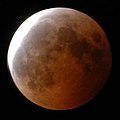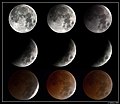October 2004 lunar eclipse
A total lunar eclipse occurred at the Moon’s ascending node of orbit on Thursday, October 28, 2004, with an umbral magnitude of 1.3100. A lunar eclipse occurs when the Moon moves into the Earth's shadow, causing the Moon to be darkened. A total lunar eclipse occurs when the Moon's near side entirely passes into the Earth's umbral shadow. Unlike a solar eclipse, which can only be viewed from a relatively small area of the world, a lunar eclipse may be viewed from anywhere on the night side of Earth. A total lunar eclipse can last up to nearly two hours, while a total solar eclipse lasts only a few minutes at any given place, because the Moon's shadow is smaller. Occurring about 5.4 days before apogee (on November 2, 2004, at 13:10 UTC), the Moon's apparent diameter was smaller.
This lunar eclipse is the last of a tetrad, with four total lunar eclipses in series, the others being on May 16, 2003; November 9, 2004; and May 4, 2004.
Visibility
The eclipse was completely visible over much of North and South America, west Africa, and western Europe, seen rising over western North America and the Pacific Ocean and setting over Africa, eastern Europe, and west Asia.
Gallery
- Timelapse photo from Hayward, California
- Ault Field, Washington, 2:29 UT
- Dunkirk, Maryland, 3:03 UT
- From Kiuruvesi, Finland, 3:21 UT
- Seattle, Washington
End of totality, 3:43 UT - Bellevue, Washington, 3:51 UT
- Timelapse photo from A Coruña, Spain
Eclipse details
Shown below is a table displaying details about this particular solar eclipse. It describes various parameters pertaining to this eclipse.
Eclipse season
This eclipse is part of an eclipse season, a period, roughly every six months, when eclipses occur. Only two (or occasionally three) eclipse seasons occur each year, and each season lasts about 35 days and repeats just short of six months (173 days) later; thus two full eclipse seasons always occur each year. Either two or three eclipses happen each eclipse season. In the sequence below, each eclipse is separated by a fortnight.
Related eclipses
Eclipses in 2004
- A partial solar eclipse on April 19.
- A total lunar eclipse on May 4.
- A partial solar eclipse on October 14.
- A total lunar eclipse on October 28.
Metonic
- Preceded by: Lunar eclipse of January 9, 2001
- Followed by: Lunar eclipse of August 16, 2008
Tzolkinex
- Preceded by: Lunar eclipse of September 16, 1997
- Followed by: Lunar eclipse of December 10, 2011
Half-Saros
- Preceded by: Solar eclipse of October 24, 1995
- Followed by: Solar eclipse of November 3, 2013
Tritos
- Preceded by: Lunar eclipse of November 29, 1993
- Followed by: Lunar eclipse of September 28, 2015
Lunar Saros 136
- Preceded by: Lunar eclipse of October 17, 1986
- Followed by: Lunar eclipse of November 8, 2022
Inex
- Preceded by: Lunar eclipse of November 18, 1975
- Followed by: Lunar eclipse of October 8, 2033
Triad
- Preceded by: Lunar eclipse of December 28, 1917
- Followed by: Lunar eclipse of August 29, 2091
Lunar eclipses of 2002–2005
This eclipse is a member of a semester series. An eclipse in a semester series of lunar eclipses repeats approximately every 177 days and 4 hours (a semester) at alternating nodes of the Moon's orbit.
The penumbral lunar eclipse on June 24, 2002 occurs in the previous lunar year eclipse set.
Metonic series
The metonic cycle repeats nearly exactly every 19 years and represents a Saros cycle plus one lunar year. Because it occurs on the same calendar date, the Earth's shadow will in nearly the same location relative to the background stars.
Saros 136
This eclipse is a part of Saros series 136, repeating every 18 years, 11 days, and containing 72 events. The series started with a penumbral lunar eclipse on April 13, 1680. It contains partial eclipses from July 11, 1824 through September 14, 1932; total eclipses from September 26, 1950 through July 7, 2419; and a second set of partial eclipses from July 18, 2437 through October 3, 2563. The series ends at member 72 as a penumbral eclipse on June 1, 2960.
The longest duration of totality will be produced by member 35 at 101 minutes, 23 seconds on April 21, 2293. All eclipses in this series occur at the Moon’s ascending node of orbit.
Eclipses are tabulated in three columns; every third eclipse in the same column is one exeligmos apart, so they all cast shadows over approximately the same parts of the Earth.
Tritos series
This eclipse is a part of a tritos cycle, repeating at alternating nodes every 135 synodic months (≈ 3986.63 days, or 11 years minus 1 month). Their appearance and longitude are irregular due to a lack of synchronization with the anomalistic month (period of perigee), but groupings of 3 tritos cycles (≈ 33 years minus 3 months) come close (≈ 434.044 anomalistic months), so eclipses are similar in these groupings.
Inex series
This eclipse is a part of the long period inex cycle, repeating at alternating nodes, every 358 synodic months (≈ 10,571.95 days, or 29 years minus 20 days). Their appearance and longitude are irregular due to a lack of synchronization with the anomalistic month (period of perigee). However, groupings of 3 inex cycles (≈ 87 years minus 2 months) comes close (≈ 1,151.02 anomalistic months), so eclipses are similar in these groupings.
Half-Saros cycle
A lunar eclipse will be preceded and followed by solar eclipses by 9 years and 5.5 days (a half saros). This lunar eclipse is related to two solar eclipses of Solar Saros 143.
See also
- List of lunar eclipses and List of 21st-century lunar eclipses
- May 2003 lunar eclipse
- November 2003 lunar eclipse
- May 2004 lunar eclipse
Notes
External links
- NASA
- Total Lunar Eclipse of Oct. 27, 2004
- 2004 Oct 28 chart: Eclipse Predictions by Fred Espenak, NASA/GSFC
- Saros series 136
- NASA Astronomy Picture of the Day: Red Moon Triple (29 October 2004)
- NASA Astronomy Picture of the Day: Pumpkin Moon (30 October 2004)
- Lunar Eclipse gallery
- Photo by Wade B Clark Jr. near Lyman, Washington, USA
- [1]
- Spaceweather.com: Lunar eclipse gallery






